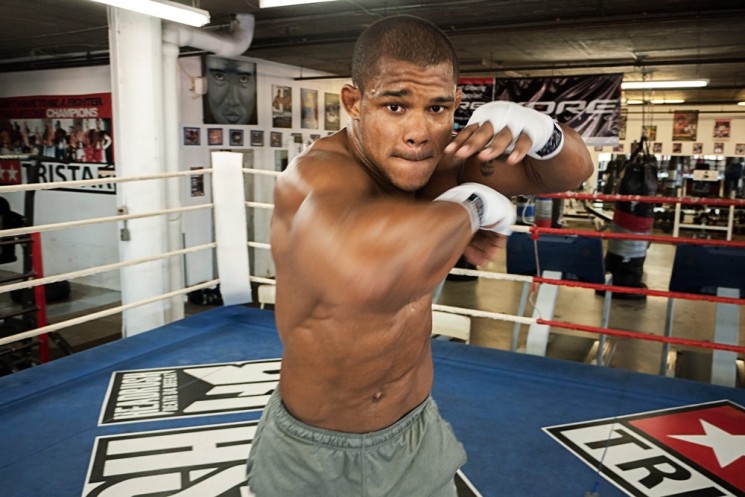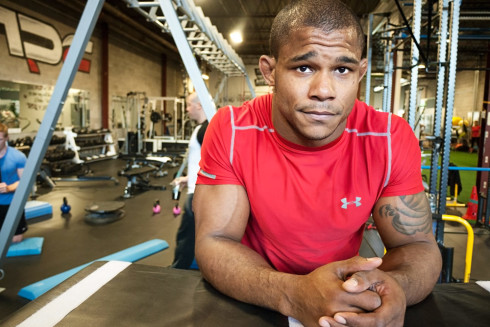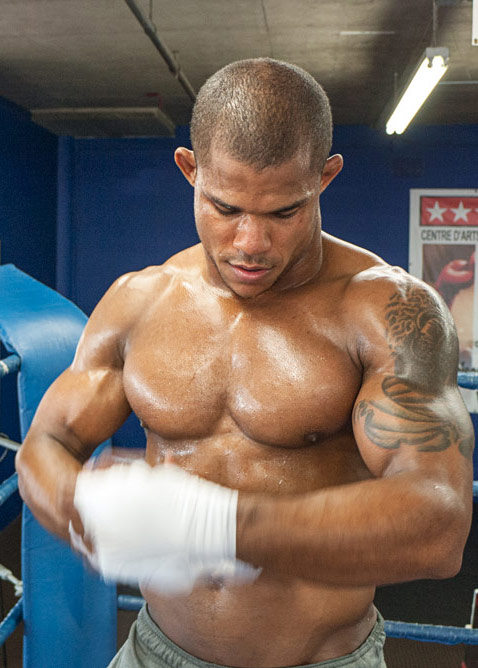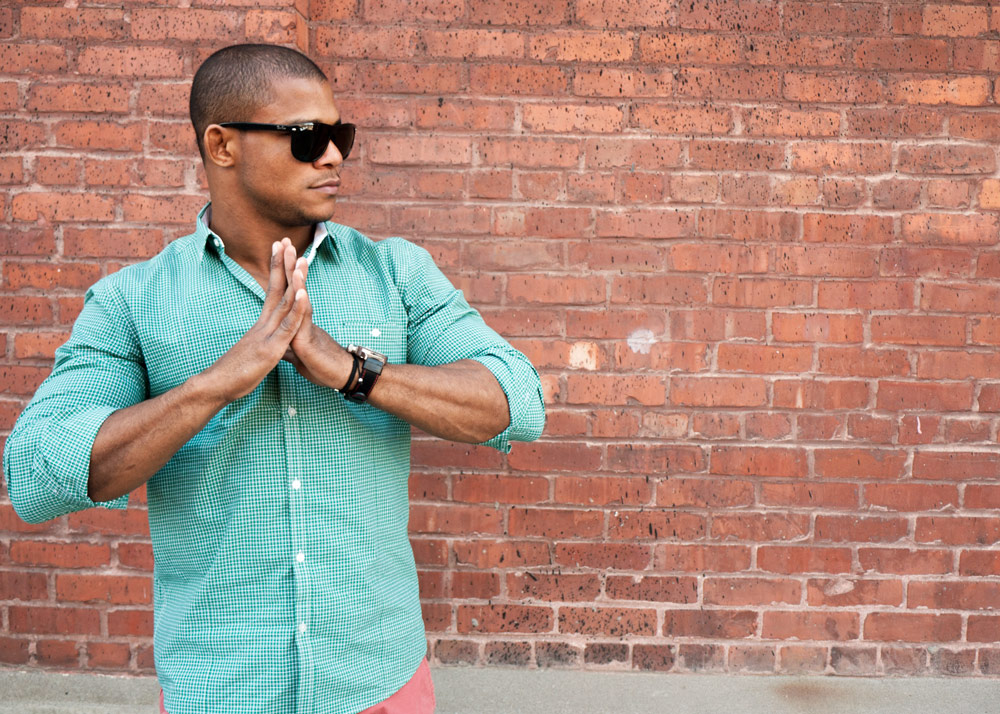
Alex Garcia
The dreams this nightmare is made of
Close your eyes and imagine someone you care about stepping onto a stage and into a caged octagon at the center of a 10,000-seat stadium to endure what you envision will be a blood-soaked brutalized grappling between two people, and the only ending you can foresee is a gladiator-style finish with only one person walking away… alive.
Slinking down into my narrow seat at the Bell Center in Montreal my hands shook, gripped to my event brochure, which was already tightly rolled. I forced myself to take a deep breath. I had already snapped at two people who I was convinced were purposely “trying to make me late for the fight” and could barely manage to balance my way down the four-inch wide stairs on my wobbly legs. To put it mildly, I was nervous.
I’ll set the picture: rowdy crowds, spotlights, big screens, large-scale promotional posters, entrance songs and entourages. We had officially entered the world of M.M.A. Although there were ten fights and twenty fighters listed in my program book, there was only one person we were there to see.
Garcia misses a left, MacGrath ducks, Garcia jets at him dodging a knee thrown by MacGrath. They hit the ground; Garcia throws a left punch, and a few more. Over.
Thirty-four seconds. What can you do in 34 seconds? Reheat a pizza pocket? Receive and send a great Snapchat? Get a good sense of Pitbull’s entire discography? What we can tell you for certain is what M.M.A. up-and-coming star Alex “The Dominican Nightmare” Garcia can do in thirty-four seconds: knock somebody’s lights out.
Was the fight barbaric, brutal and deadly? No. The reality of the evening was that the sport is elegant, graceful and, more than anything, a great display of athleticism. According to Garcia, one of the sport’s most promising rising stars, notions of cockfighting and negative media attention are unwarranted. “I don’t think it’s particularly violent. We train for it. It’s balanced. We train our bodies to do all that,” he says. “If anything, American football is more dangerous. Even boxing is more brutal.” Mixed Martial Arts, or M.M.A., is a full contact combat sport that blends multiple fighting disciplines, adheres to strict unified rules and encompasses dozens of leagues and organizations – of which the best known is the U.F.C..

“Each match will run until there is a designated winner – by means of knockout, surrender, doctor’s intervention or death.” – UFC
Read the press release for the first Ultimate Fighting Championship, back in 1993. It attracted 90,000 pay-per-view customers and outraged millions, who not so affectionately dubbed the sport “human cockfighting”. Amid the outcries and the cheers, the sport of M.M.A. was born and ready to shake up North American professional fighting, which up until then was limited to boxing and wrestling.
M.M.A. has come a long way since its controversial debut. Gone are the days where fights are unsanctioned bouts, outlawed in most American states and banned from major cable television networks. Once called a “violent sport not worthy of our society” by state assemblyman Bob Reilly, the most outspoken of the anti-M.M.A. movement, the sport now earns more pay-per-view revenue than both boxing and wrestling, thanks to a few rule changes and many clever marketing tricks.
Its development within the last twenty years has been tremendous. “Muay thai, jiu-jitsu, wrestling, boxing, kickboxing, gymnastics…” Garcia runs off the list of training styles he practices in order to perform his best in the octagon. The striking styles of boxing, kickboxing and karate are combined with the grappling based arts of jiu-jitsu and wrestling to complete a truly well-rounded fighter.
The evolution of M.M.A. has seen the addition of these styles of martial arts becoming crucial to a competitor’s success, making for more multidimensional fighters and relatively safer battles. The British Journal of Sports Medicine published a study that revealed only 28 percent of M.M.A. fights are decided by a blow to the head; most brawls are decided on the floor in a wrestling match.

I never think that.
“I fight with my mind, not my hands,” he says – a quote that resonates strongly if you’ve ever actually seen an Alex Garcia fight. His 9-1-0 record speaks volumes for this young fighter, known to study his opponents at length. “I know [my opponents]. I know the way they fight better than they know themselves. I watch them every night for months. Every time they make a move, I know what they’re planning on doing.” Mental preparedness is a natural aspect of professional sports. If Mr. Miagi taught us anything, it’s to use our heads for something other than a target.
Garcia is no stranger to the risks involved: “I know it’s my career, my life on the line. I have to take it seriously.” He will fully admit that the reality of his sport is bloody and injuries do tend to occur, but reminds us that there are sanctioned rules and regulations, referees, multiple judges and strict precautionary actions such as pre-fight drug testing implemented to create a fair competition. And in case that doesn’t pacify the naysayers, he laughs: “It’s only blood. We are made of blood.”
On April 24th 2009, just shy of his 22nd birthday, Garcia left his hometown in the Dominican Republic, his two sisters, three brothers and beloved mother to make the most important move of his professional fighting career: the move to Montreal. “It was easy for me to come here. I’ve always had an open mind to start a new life,” he remembers. He quickly made friends with welterweight champion George St-Pierre, who later helped him settle into a spot at Tristar gym under acclaimed coach Firas Zahabi. He had clearly found himself a new home. “One day [George] brought me to Tristar to train with him,” he says. “It was fun. He helped me a lot mentally. I got to ask him a lot of questions. At the time I didn’t know anything.” It’s hard to believe that a mere four years ago Garcia didn’t know anything about the sport he is now starting to dominate; or that a year ago he suffered a knee injury that would have halted most professional athletes’ careers.
Yes, Garcia tore his ACL in the winter of 2012. “What went through my mind? Everything. Everything except, ‘my career is done’. I never think that. I’m just like, ‘fuck, I have to start all over again.’” A testament to the dedication he continually exerts towards his sport; especially brave considering he was coming off of his sixth career win (the famous 34-second fight against Matt MacGrath).

He spent nine weeks by himself recovering from surgery in a hotel in California. “It was tough. It was painful. I never wish that to anybody,” he says of his time alone. But even the great amount of pain and the 5,000 kilometers between his hometown and him weren’t enough to make him give up.
He was welcomed back to Montreal by his adoptive family – “my coaches and my friends” – to finish his eight-month rehab. “I had positive people around me and they still believed I could reach my goals.” He continually attributes his successes to the city that took him in as its own. It was this same support system that eased the pain of rehabilitating himself back into fighting shape.
“When I’m in good shape, I have nothing to be nervous about,” he says. He remembers feeling confident about his official clearance by his doctors and his fearlessness to step back into the octagon. “I feel like I need to work hard enough so that during the fight I don’t ask myself any questions. I’ll spend six weeks, seven weeks training so that I don’t have to go into the ring asking myself those questions. I just want to get in there and be able to fight.”
The beauty of studying an up-and-comer such as Garcia is being able to watch the evolution of an athlete. Watching him grow into his confidence and hone his fighting styles, again proving that mixed martial arts is as worthy a professional sport as any. Glancing over his track record, you would think that his multiple first-round KOs were the highlights of his career, but, in his eyes, his first (and only) career loss to Seth Baczynski and his most recent win against the [then-]undefeated Ryan Dickson are the defining moments of his professional career.
Being a successful athlete comes with its ups and downs. Today Garcia has polished his skills and his continual growth has even caught the eyes of the officials of Bellator, a high profile M.A.A. league, but it was a big blow to his ego that has propelled him to where he is today. “I thought I was invincible. I didn’t work as hard,” he says intently remembering his loss to Seth Baczynski back in 2011. “I wasn’t fighting with my mind. I was fighting with my heart. It’s different. You can fight emotionally, or you can fight smart. I fought emotionally.” It’s almost sobering to hear Garcia speak so intensely of this experience. He is a comic by nature and although he always takes competition seriously, his tone has changed. “It was one of the best thing that ever happened to me. I learned so much about myself and about my sport. I hadn’t lived before. Now I have lived.”
It all comes back to the most important quote Garcia gave us:
It’s been over two years, one major surgery, eight months of rehab, one thirty four-second KO and two other major wins since that day. When he said, “Now it’s time to do my best, to do what I have to do to make sure it never happens again,” he wasn’t kidding around.
Dickson came into the fight last May with a 5-0-0 record and has been mentioned all over the blogosphere as a great potential opponent for any of the top Canadian M.M.A. fighters. Both fighters walked away bloodied and exhausted, but Garcia clearly controlled the three-round fight, as decided by the judges unanimously. “People always think I’m a one-round guy. That’s bad if you can’t do three rounds,” he says with a smile. “But if you’re a one-round guy who can go three rounds, that’s good. Now people know I can last.” Being able to showcase his strengths as a fighter – the ability to remain calm, his wrestling skills on the mat and his overall endurance – was key to developing his profile as he climbs the top 10 rankings in Canada.

So what’s next for this rising M.M.A. star? Well, we’ve established that the sport is going nowhere but up and with a 9-1-0 record he has opened many doors. As true as that may be, he is cautious to not get ahead of himself. “If you rush in and are not ready, you’ll get your ass kicked,” he says of entering the highly acclaimed U.F.C. league. “In the U.F.C., everybody’s tough. Everybody wants to be there. Everybody wants your spot. So I’ll stay outside maybe a year more, learn, prove myself, get better at boxing. I can focus on getting better from the outside.”
Above all else his end goal is to be one of the best of all-time. “To be a legend. A lot of people can be a fighter. Not many can be a legend,” Garcia says smiling. He rarely isn’t smiling, but why shouldn’t he? He’s got a lot to smile about.
Close your eyes and imagine someone you care about stepping onto a stage and into a caged octagon at the center of a 10,000-seat stadium to endure what you envision will be a blood-soaked brutalized grappling between two people, and the only ending you can foresee is a gladiator-style finish with only one person walking away… alive.
Slinking down into my narrow seat at the Bell Center in Montreal my hands shook, gripped to my event brochure, which was already tightly rolled. I forced myself to take a deep breath. I had already snapped at two people who I was convinced were purposely “trying to make me late for the fight” and could barely manage to balance my way down the four-inch wide stairs on my wobbly legs. To put it mildly, I was nervous.
I’ll set the picture: rowdy crowds, spotlights, big screens, large-scale promotional posters, entrance songs and entourages. We had officially entered the world of M.M.A. Although there were ten fights and twenty fighters listed in my program book, there was only one person we were there to see.
Garcia misses a left, MacGrath ducks, Garcia jets at him dodging a knee thrown by MacGrath. They hit the ground; Garcia throws a left punch, and a few more. Over.
It’s only blood. We're all made of blood.Thirty-four seconds. What can you do in 34 seconds? Reheat a pizza pocket? Receive and send a great Snapchat? Get a good sense of Pitbull's entire discography? What we can tell you for certain is what M.M.A. up-and-coming star Alex “The Dominican Nightmare” Garcia can do in thirty-four seconds: knock somebody’s lights out.
Was the fight barbaric, brutal and deadly? No. The reality of the evening was that the sport is elegant, graceful and, more than anything, a great display of athleticism. According to Garcia, one of the sport’s most promising rising stars, notions of cockfighting and negative media attention are unwarranted. “I don’t think it’s particularly violent. We train for it. It’s balanced. We train our bodies to do all that,” he says. “If anything, American football is more dangerous. Even boxing is more brutal.” Mixed Martial Arts, or M.M.A., is a full contact combat sport that blends multiple fighting disciplines, adheres to strict unified rules and encompasses dozens of leagues and organizations - of which the best known is the U.F.C..

“Each match will run until there is a designated winner - by means of knockout, surrender, doctor's intervention or death.” - UFC
Read the press release for the first Ultimate Fighting Championship, back in 1993. It attracted 90,000 pay-per-view customers and outraged millions, who not so affectionately dubbed the sport “human cockfighting”. Amid the outcries and the cheers, the sport of M.M.A. was born and ready to shake up North American professional fighting, which up until then was limited to boxing and wrestling.
I don’t think it’s particularly violent. We train for it. It’s balanced. We train our bodies to do all that.M.M.A. has come a long way since its controversial debut. Gone are the days where fights are unsanctioned bouts, outlawed in most American states and banned from major cable television networks. Once called a “violent sport not worthy of our society” by state assemblyman Bob Reilly, the most outspoken of the anti-M.M.A. movement, the sport now earns more pay-per-view revenue than both boxing and wrestling, thanks to a few rule changes and many clever marketing tricks.
Its development within the last twenty years has been tremendous. “Muay thai, jiu-jitsu, wrestling, boxing, kickboxing, gymnastics…” Garcia runs off the list of training styles he practices in order to perform his best in the octagon. The striking styles of boxing, kickboxing and karate are combined with the grappling based arts of jiu-jitsu and wrestling to complete a truly well-rounded fighter.
The evolution of M.M.A. has seen the addition of these styles of martial arts becoming crucial to a competitor’s success, making for more multidimensional fighters and relatively safer battles. The British Journal of Sports Medicine published a study that revealed only 28 percent of M.M.A. fights are decided by a blow to the head; most brawls are decided on the floor in a wrestling match.

I never think that.
“I fight with my mind, not my hands,” he says - a quote that resonates strongly if you’ve ever actually seen an Alex Garcia fight. His 9-1-0 record speaks volumes for this young fighter, known to study his opponents at length. “I know [my opponents]. I know the way they fight better than they know themselves. I watch them every night for months. Every time they make a move, I know what they’re planning on doing.” Mental preparedness is a natural aspect of professional sports. If Mr. Miagi taught us anything, it’s to use our heads for something other than a target.
Garcia is no stranger to the risks involved: “I know it’s my career, my life on the line. I have to take it seriously.” He will fully admit that the reality of his sport is bloody and injuries do tend to occur, but reminds us that there are sanctioned rules and regulations, referees, multiple judges and strict precautionary actions such as pre-fight drug testing implemented to create a fair competition. And in case that doesn’t pacify the naysayers, he laughs: “It’s only blood. We are made of blood.”
On April 24th 2009, just shy of his 22nd birthday, Garcia left his hometown in the Dominican Republic, his two sisters, three brothers and beloved mother to make the most important move of his professional fighting career: the move to Montreal. “It was easy for me to come here. I’ve always had an open mind to start a new life,” he remembers. He quickly made friends with welterweight champion George St-Pierre, who later helped him settle into a spot at Tristar gym under acclaimed coach Firas Zahabi. He had clearly found himself a new home. “One day [George] brought me to Tristar to train with him,” he says. “It was fun. He helped me a lot mentally. I got to ask him a lot of questions. At the time I didn’t know anything.” It’s hard to believe that a mere four years ago Garcia didn’t know anything about the sport he is now starting to dominate; or that a year ago he suffered a knee injury that would have halted most professional athletes’ careers.
Yes, Garcia tore his ACL in the winter of 2012. “What went through my mind? Everything. Everything except, ‘my career is done’. I never think that. I’m just like, ‘fuck, I have to start all over again.’” A testament to the dedication he continually exerts towards his sport; especially brave considering he was coming off of his sixth career win (the famous 34-second fight against Matt MacGrath).

He spent nine weeks by himself recovering from surgery in a hotel in California. “It was tough. It was painful. I never wish that to anybody,” he says of his time alone. But even the great amount of pain and the 5,000 kilometers between his hometown and him weren’t enough to make him give up.
He was welcomed back to Montreal by his adoptive family - “my coaches and my friends” - to finish his eight-month rehab. “I had positive people around me and they still believed I could reach my goals.” He continually attributes his successes to the city that took him in as its own. It was this same support system that eased the pain of rehabilitating himself back into fighting shape.
“When I’m in good shape, I have nothing to be nervous about,” he says. He remembers feeling confident about his official clearance by his doctors and his fearlessness to step back into the octagon. “I feel like I need to work hard enough so that during the fight I don’t ask myself any questions. I’ll spend six weeks, seven weeks training so that I don’t have to go into the ring asking myself those questions. I just want to get in there and be able to fight.”
The beauty of studying an up-and-comer such as Garcia is being able to watch the evolution of an athlete. Watching him grow into his confidence and hone his fighting styles, again proving that mixed martial arts is as worthy a professional sport as any. Glancing over his track record, you would think that his multiple first-round KOs were the highlights of his career, but, in his eyes, his first (and only) career loss to Seth Baczynski and his most recent win against the [then-]undefeated Ryan Dickson are the defining moments of his professional career.
Being a successful athlete comes with its ups and downs. Today Garcia has polished his skills and his continual growth has even caught the eyes of the officials of Bellator, a high profile M.A.A. league, but it was a big blow to his ego that has propelled him to where he is today. “I thought I was invincible. I didn’t work as hard,” he says intently remembering his loss to Seth Baczynski back in 2011. “I wasn’t fighting with my mind. I was fighting with my heart. It’s different. You can fight emotionally, or you can fight smart. I fought emotionally.” It’s almost sobering to hear Garcia speak so intensely of this experience. He is a comic by nature and although he always takes competition seriously, his tone has changed. “It was one of the best thing that ever happened to me. I learned so much about myself and about my sport. I hadn’t lived before. Now I have lived.”
It all comes back to the most important quote Garcia gave us:
“I fight with my mind, not my hands.”It’s been over two years, one major surgery, eight months of rehab, one thirty four-second KO and two other major wins since that day. When he said, “Now it’s time to do my best, to do what I have to do to make sure it never happens again,” he wasn’t kidding around.
Dickson came into the fight last May with a 5-0-0 record and has been mentioned all over the blogosphere as a great potential opponent for any of the top Canadian M.M.A. fighters. Both fighters walked away bloodied and exhausted, but Garcia clearly controlled the three-round fight, as decided by the judges unanimously. “People always think I’m a one-round guy. That’s bad if you can’t do three rounds,” he says with a smile. “But if you’re a one-round guy who can go three rounds, that’s good. Now people know I can last.” Being able to showcase his strengths as a fighter - the ability to remain calm, his wrestling skills on the mat and his overall endurance - was key to developing his profile as he climbs the top 10 rankings in Canada.

So what’s next for this rising M.M.A. star? Well, we’ve established that the sport is going nowhere but up and with a 9-1-0 record he has opened many doors. As true as that may be, he is cautious to not get ahead of himself. “If you rush in and are not ready, you’ll get your ass kicked,” he says of entering the highly acclaimed U.F.C. league. “In the U.F.C., everybody’s tough. Everybody wants to be there. Everybody wants your spot. So I’ll stay outside maybe a year more, learn, prove myself, get better at boxing. I can focus on getting better from the outside.”
Above all else his end goal is to be one of the best of all-time. “To be a legend. A lot of people can be a fighter. Not many can be a legend,” Garcia says smiling. He rarely isn’t smiling, but why shouldn’t he? He’s got a lot to smile about.
